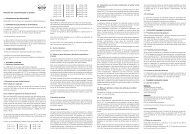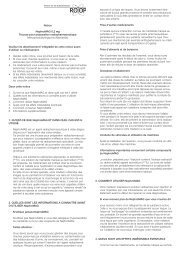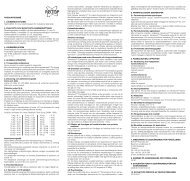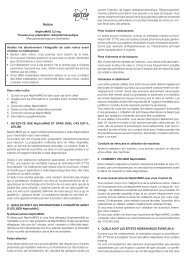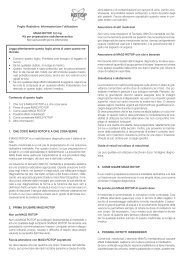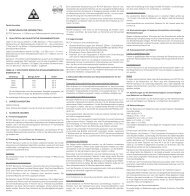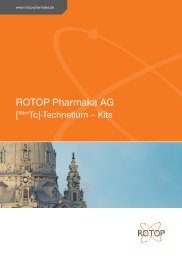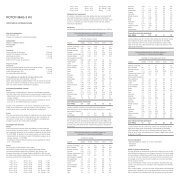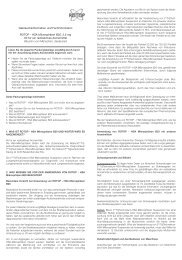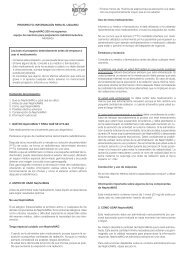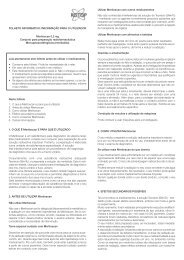Package Leaflet: Information for the user NephroMAG 0.2 mg Kit for ...
Package Leaflet: Information for the user NephroMAG 0.2 mg Kit for ...
Package Leaflet: Information for the user NephroMAG 0.2 mg Kit for ...
You also want an ePaper? Increase the reach of your titles
YUMPU automatically turns print PDFs into web optimized ePapers that Google loves.
treat or prevent organ transplant rejection).<br />
Using <strong>NephroMAG</strong> with food and drink<br />
In this leaflet<br />
<strong>Package</strong> <strong>Leaflet</strong>: <strong>In<strong>for</strong>mation</strong> <strong>for</strong> <strong>the</strong> <strong>user</strong><br />
<strong>NephroMAG</strong> <strong>0.2</strong> <strong>mg</strong><br />
<strong>Kit</strong> <strong>for</strong> radiopharmaceutical preparation<br />
Mercaptoacetyltriglycine (Mertiatide)<br />
Read all of this leaflet carefully be<strong>for</strong>e you start using this<br />
medicine.<br />
• Keep this leaflet. You may need to read it again.<br />
• If you have fur<strong>the</strong>r questions, please ask your doctor.<br />
• This medicine has been prescribed <strong>for</strong> you. Do not pass it on to<br />
o<strong>the</strong>rs. It may harm <strong>the</strong>m, even if <strong>the</strong>ir symptoms are <strong>the</strong> same<br />
as yours.<br />
• If any of <strong>the</strong> side effects gets serious, or if you notice any side<br />
effects not listed in this leaflet, please tell your doctor.<br />
1. What <strong>NephroMAG</strong> is and what it is used <strong>for</strong><br />
2. Be<strong>for</strong>e you use <strong>NephroMAG</strong><br />
3. How to use <strong>NephroMAG</strong><br />
4. Possible side effects<br />
5. How to store <strong>NephroMAG</strong><br />
6. Fur<strong>the</strong>r in<strong>for</strong>mation<br />
1. WHAT <strong>NephroMAG</strong> IS AND WHAT IT IS USED FOR<br />
<strong>NephroMAG</strong> is a diagnostic radiopharmaceutical <strong>for</strong> <strong>the</strong> renal system.<br />
This medicine is a kit to prepare a radioactive solution <strong>for</strong> injection.<br />
There<strong>for</strong>e <strong>the</strong> preparation takes place in a specialized radio-pharmacy<br />
unit. The final solution <strong>for</strong> injection serves to apply a diagnostic<br />
imaging procedure of your kidneys and urinary tract.<br />
Toge<strong>the</strong>r with a suitable radioactive substance technetium-(99mTc)<br />
mertiatide solution is prepared. This is indicated in babies, children<br />
and adults <strong>for</strong> diagnostic investigations of <strong>the</strong> kidneys, <strong>the</strong> urinary<br />
tract and <strong>the</strong> urinary flow.<br />
Using a special camera your doctor will obtain images which allow to<br />
watch your kidneys work and to diagnose <strong>for</strong>m and function of your<br />
kidneys and entire urinary tract. Regarded is how well your kidneys<br />
are able to clear your blood (clearance) from <strong>the</strong> substance injected<br />
and your urinary system is able to excrete it afterwards.<br />
2. BEFORE YOU USE <strong>NephroMAG</strong><br />
Do not use <strong>NephroMAG</strong><br />
Do not use <strong>NephroMAG</strong> if you are allergic (hypersensitive) to<br />
mertiatide or any of <strong>the</strong> o<strong>the</strong>r ingredients of <strong>NephroMAG</strong>. If <strong>the</strong> allergic<br />
symptoms, such as urticaria, pruritus, nausea or difficulty in breathing<br />
were developed during <strong>the</strong> previous examination, <strong>the</strong> necessity of <strong>the</strong><br />
intervention should be considered.<br />
Take special care with <strong>NephroMAG</strong><br />
You should know that you may create risks <strong>for</strong> o<strong>the</strong>rs from external<br />
radiation or contamination from spills of urine, vomiting, etc. <strong>for</strong> some<br />
hours once you have been injected with <strong>the</strong> pharmaceutical. Vice<br />
versa you could be subjected to risks from o<strong>the</strong>r patients. Particular<br />
care you should take when you get in close contact with children.<br />
Taking o<strong>the</strong>r medicines<br />
Technetium-(99mTc) mertiatide is not known to interfere with agents<br />
commonly prescribed to patients requiring <strong>the</strong> above mentioned<br />
investigations (e.g. antihypertensives and medicinal agents used to<br />
Drink plenty of water be<strong>for</strong>e <strong>the</strong> examination starts to allow optimal<br />
results of <strong>the</strong> investigation. Empty your bladder as often as possible<br />
during <strong>the</strong> first hours after <strong>the</strong> examination in order to reduce<br />
radiation.<br />
Pregnancy and breast-feeding<br />
So-called radionuclide procedures on pregnant women also involve<br />
radiation doses to <strong>the</strong> foetus which could endanger <strong>the</strong> healthy<br />
development. Only imperative investigations should be carried out<br />
during pregnancy, when <strong>the</strong> likely benefit exceeds <strong>the</strong> risk incurred by<br />
mo<strong>the</strong>r and foetus. There must be urgent and important medical<br />
reasons to justify <strong>the</strong> investigation during pregnancy.<br />
You should be assumed pregnant if you are missing a period.<br />
Alternative techniques which do not involve ionising radiation should<br />
be considered <strong>the</strong>n.<br />
If you are a breast-feeding mo<strong>the</strong>r you should interrupt breast-feeding<br />
<strong>for</strong> 24 hours and discard <strong>the</strong> expressed feeds. Moreover, to protect<br />
from radioactivity transmission, <strong>the</strong> mo<strong>the</strong>r is recommended to avoid<br />
close contact to <strong>the</strong> baby during <strong>the</strong> initial 24 hours following<br />
injection. Ask your doctor <strong>for</strong> specific advice.<br />
Driving and using machines<br />
You may drive and use machines after <strong>the</strong> investigation.<br />
3. HOW TO USE <strong>NephroMAG</strong><br />
Your doctor will prepare <strong>the</strong> radioactive solution <strong>for</strong> injection and will<br />
inject it intravenously as a single shot immediately be<strong>for</strong>e <strong>the</strong><br />
diagnostic examination starts.<br />
If you get more <strong>NephroMAG</strong> than you should<br />
Your medicinal product will be administered by doctor in strictly<br />
defined conditions, so <strong>the</strong>re is hardly anything to be expected from<br />
that side. The risk of a radiation overdose is hardly to happen. You can<br />
always reduce radiation to your body if you drink plenty of water and<br />
void your bladder frequently. If necessary, your doctor may support<br />
excretion with some o<strong>the</strong>r medicine (<strong>for</strong>ced diuresis).<br />
If you have any fur<strong>the</strong>r questions on <strong>the</strong> use of this product, ask your<br />
doctor.<br />
4. POSSIBLE SIDE EFFECTS<br />
Like all medicines, technetium-(99mTc) mertiatide can cause side<br />
effects, although not everybody gets <strong>the</strong>m.<br />
Mostly mild anaphylactoid reactions characterised by uriticarial rash,<br />
swelling of eyelids and coughing have been reported very rarely in less<br />
than 1 out of 10,000 patients. Occasionally circulatory disorders of a<br />
mild nature (characterized by sudden dizziness or fainting) have been<br />
reported.<br />
Your doctor is aware to treat <strong>the</strong>se immediately if necessary.<br />
Exposure to ionisation radiation is linked with cancer induction and a<br />
potential <strong>for</strong> development of hereditary defects. However, <strong>the</strong><br />
absorbed radiation dose is probably much lesser than that<br />
radioactivity you are naturally exposed to during a year in your normal<br />
environment. For diagnostic nuclear medicine procedures <strong>the</strong>se<br />
adverse effects will occur with low frequency because of <strong>the</strong> low<br />
radiation doses incurred.<br />
If you suffer from reduced kidney function an increased radiation<br />
exposure can be <strong>the</strong> consequence. If any of <strong>the</strong> side effects gets<br />
serious, or if you notice any side effects not listed in this leaflet, tell<br />
your doctor at once.<br />
5. HOW TO STORE <strong>NephroMAG</strong><br />
Generally this medicine is stored at your doctor’s place since <strong>the</strong>re are<br />
special requirements.
Store in a refrigerator at 2 – 8 °C.<br />
Store in <strong>the</strong> original package in order to protect from light.<br />
The labelled preparation must be stored at 2 – 8 °C <strong>for</strong> aseptic<br />
reasons.<br />
Storage should be in accordance with national regulations <strong>for</strong><br />
radioactive material.<br />
6. FURTHER INFORMATION<br />
What <strong>NephroMAG</strong> contains<br />
The active substance is <strong>0.2</strong> <strong>mg</strong> mercaptoacetyltriglycine (mertiatide)<br />
in vial (1). The o<strong>the</strong>r ingredients are stannous chloride dihydrate,<br />
disodium (R,R)-tartrate dihydrate, sodium hydroxide, hydrochloric<br />
acid, sodium monohydrogenphosphate dihydrate, sodium<br />
dihydrogenphosphate dihydrate.<br />
What <strong>NephroMAG</strong> looks like and content of <strong>the</strong> pack<br />
<strong>NephroMAG</strong> consists of 2 different vials, 5 of each kind in one box.<br />
Vial (1) contains a powder with <strong>0.2</strong> <strong>mg</strong> of <strong>the</strong> active substance<br />
mertiatide; vial (2) contains 2.5 ml of phosphate buffer solution.<br />
Marketing Authorisation Holder and Manufacturer<br />
ROTOP Pharmaka AG<br />
Bautzner Landstrasse 45<br />
01454 Radeberg<br />
Federal Republic of Germany<br />
Fon +49 351 26 95 395<br />
Fax +49 351 26 95 311<br />
E-Mail: info@rotop-pharmaka.de<br />
Local Representative<br />
N.N.<br />
This medicinal product is authorised in <strong>the</strong> Member States of <strong>the</strong><br />
EEA under <strong>the</strong> following names:<br />
Germany<br />
Spain<br />
Hungary<br />
The Ne<strong>the</strong>rlands<br />
Finland<br />
Greece<br />
France<br />
Portugal<br />
Sweden<br />
Belgium<br />
Norway<br />
Italy<br />
MAG-3 <strong>Kit</strong><br />
<strong>NephroMAG</strong><br />
<strong>NephroMAG</strong><br />
<strong>NephroMAG</strong><br />
<strong>NephroMAG</strong><br />
<strong>NephroMAG</strong><br />
<strong>NephroMAG</strong><br />
Mertioscan<br />
<strong>NephroMAG</strong><br />
<strong>NephroMAG</strong><br />
Nephromag<br />
MAG3 ROTOP<br />
Reduction of radioactivity to less than 10 % of <strong>the</strong> activity adults<br />
receive will generally result in technically unsatisfactory procedures.<br />
3 kg = 0.1 22 kg = 0.5 42 kg = 0.78<br />
4 kg = 0.14 24 kg = 0.53 44 kg = 0.80<br />
6 kg = 0.19 26 kg = 0.56 46 kg = 0.82<br />
8 kg = <strong>0.2</strong>3 28 kg = 0.58 48 kg = 0.85<br />
10 kg = <strong>0.2</strong>7 30 kg = 0.62 50 kg = 0.88<br />
12 kg = 0.32 32 kg = 0.65 52 - 54 kg = 0.90<br />
14 kg = 0.36 34 kg = 0.68 56 - 58 kg = 0.92<br />
16 kg = 0.40 36 kg = 0.71 60 - 62 kg = 0.96<br />
18 kg = 0.44 38 kg = 0.73 64 - 66 kg = 0.98<br />
20 kg = 0.46 40 kg = 0.76 68 kg = 0.99<br />
Fraction of adult activity (Paediatric Task Group EANM, 1990).<br />
Method of Administration<br />
The radiopharmaceutical is prepared according to <strong>the</strong> following<br />
labelling instructions immediately be<strong>for</strong>e use: The labelling procedure<br />
has to be carried out under aseptic conditions.<br />
Place vial (1) into an adequate lead shielding. Swab <strong>the</strong> rubber<br />
septum with an appropriate disinfectant and let it dry.<br />
Inject 2 ml of sodium pertechnetate (99mTc) solution into vial (1) using a<br />
syringe. Then withdraw <strong>the</strong> same volume of nitrogen from <strong>the</strong> vial with<br />
<strong>the</strong> same syringe <strong>for</strong> pressure compensation.<br />
Shake <strong>the</strong> vial carefully in order to moisten <strong>the</strong> entire vial <strong>for</strong> complete<br />
dissolution of any powder.<br />
After 15 minutes reaction time transfer a volume of 2 ml buffer solution<br />
from vial (2) into vial (1) using a new syringe. Then withdraw <strong>the</strong> same<br />
volume of nitrogen from <strong>the</strong> vial with <strong>the</strong> same syringe <strong>for</strong> pressure<br />
compensation.<br />
Shake carefully <strong>for</strong> good mixing. Determine <strong>the</strong> total radioactivity and<br />
calculate <strong>the</strong> volume to be injected.<br />
If necessary, dilute with sterile isotonic saline up to a final total volume<br />
of 10 ml. Shake again <strong>for</strong> good mixing.<br />
The prepared solution <strong>for</strong> injection is administrated intravenously.<br />
The technetium-(99mTc) mertiatide should be injected within 6 hours<br />
after preparation.<br />
This leaflet was last approved in March 2011.<br />
The following in<strong>for</strong>mation is intended <strong>for</strong> medical or healthcare<br />
professionals only:<br />
Dosage<br />
Adults usually receive 40 - 200 MBq depending on <strong>the</strong> pathology to<br />
be studied and <strong>the</strong> method to be used. Studies of renal blood flow or<br />
transport through <strong>the</strong> ureters generally require a larger dose than<br />
studies of intrarenal transport, whereas renography requires smaller<br />
activities than sequential scintigraphy.<br />
Children and adolescents (aged less than 18 years)<br />
Although <strong>NephroMAG</strong> may be used in paediatric patients, <strong>for</strong>mal<br />
studies have not been per<strong>for</strong>med. Clinical experience indicates that<br />
<strong>for</strong> paediatric use <strong>the</strong> activity should be reduced.<br />
A practical approach is to adopt <strong>the</strong> recommendations of <strong>the</strong><br />
Paediatric Task Group of <strong>the</strong> European Association of Nuclear<br />
Medicine (EANM). See table below.<br />
PL-MAG3-FI-eng-05



